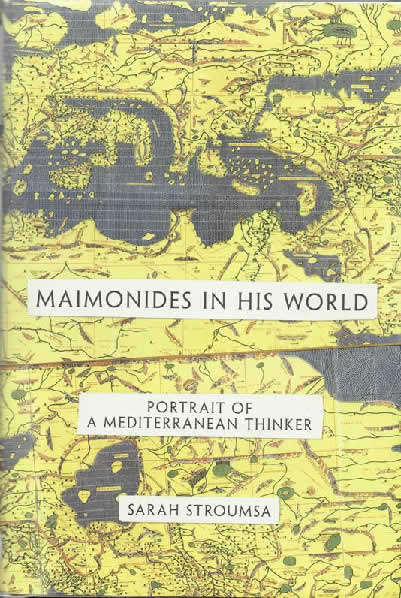Maimonides in His World: A Portrait of a Mediterranean Thinker
by Sarah Stroumsa
Princeton: Princeton University Press, 2009). ISBN 9780691137636.
Reviewed by Marc Herman

Moses Maimonides is probably the most the most extensively studied pre-modern Jew. In his own lifetime, his contemporaries recognized him as a towering intellectual and communal figure, whose writings revolutionized philosophy, law, and medicine. In our day, Maimonidean scholarship is seemingly endless. Yet, as Sarah Stroumsa notes in her path breaking biography, this scholarship often refrains from presenting a comprehensive picture of a man who transformed the Judaism of his day. Moreover, studies of Maimonides often elide his Islamicate context, giving the surrounding culture short shrift in favor of later Jewish reception of his ideas. Stroumsa’s Maimonides in His World: A Portrait of a Mediterranean Thinker fills this lacuna and provides a broader perspective on Maimonides and his time by considering all of Maimonides’ writings and placing them in their historical setting. Maimonides in His World offers new ways to think about the man, his society, and medieval Judaism as a whole, integrating a broad array of sources in an enlightening “cultural biography” (xii) that sheds light on Maimonides the thinker in his Mediterranean setting, how his multicultural context shaped his thoughts, and the genre of intellectual history writ large.
Stroumsa brings her strengths as a scholar of Arabic thought to bear on Maimonides’ biography and life’s work. She demonstrates that his was a world where ideas flowed freely between religious communities, ignoring communal boundaries and confessional affiliations, creating a “whirlpool” (xiv) of interconnected cultures. Perhaps the most important contribution emerges directly from this thesis: the challenge to a long tradition of scholarship that assumes that Maimonides only read those non-Jewish sources that he quoted. Stroumsa shows that Maimonides was frequently reticent to quote his sources and, befitting a scholar of this period, was probably familiar with the important works of his contemporaries. Maimonides famously apologized for and justified his reliance on “the truth, whoever said it,” a trope repeated by other medieval Arabic intellectuals. Similarly, integrating contemporaneous non-Jewish reports of Maimonides’ life cultivates a multifocal view of the ‘Great Eagle’. The cogence of this methodology emerges through a series of insights into Maimonides’ writings. For example, Maimonides’ portrayal of the prototypical rabbinic heretic Elisha ben Abuyah overlapped with contemporaneous depictions of Ibn al-Rāwāndī, the arch-heretic of medieval Islam (43-48). Maimonides also applied the term ‘ravings’ (hadhayānāt) to describe “pseudo-science that is not based on the evidence of the senses or on rational argument” (141) to the tenth-century Abū Bakr al-Rāzī, like many Muslim writers who rebuffed this freethinker (143-45). Stroumsa similarly argues that the Guide reacts to Averroes’ political theory even though Maimonides did not quote the political works of his Andalusian contemporary, against the position of several contemporary scholars; in fact, both authors quoted the same Qurʾānic verse in very similar contexts (73). Finally, she contends that Maimonides drew upon earlier Jewish and Muslim authors in his long battle against popular preachers who promulgated simplistic interpretations of Talmudic midrashim (118-24). These examples, together with many others, show the effectiveness of reading Maimonides in his larger setting.
Maimonides in His World also locates Maimonides in the political currents of his day. More than any other biographer, the author emphasizes the impact of the nearly two decades that Maimonides lived under Almohad rule. Stroumsa enumerates a number of possible Almohad influences on Maimonides’ life and writings, including strident anti-anthropomorphism, profound interest in the sources of the law, agnostic posture towards Ptolemaic astronomy, and the structure of the Mishneh Torah itself (53-83). She even suggests that paradoxically, Maimonides’ Judaism allowed him to integrate more elements of Almohad thought than Averroes did, as he was closer to, and consequently struggled with, the Almohad rulers (79).Through careful consideration of the primary sources, Maimonides in His World cautiously considers the possibility that Maimonides lived as a crypto-Jew in Fez after leaving Andalusia (57n18).
Stroumsa thoughtfully compares Maimonides with perhaps his only true peer in Judeo-Arabic civilization, Saʿadya ben Joseph Gaon. She notes that travels and diverse influences shaped both these figures, and both left legacies that influenced Judaism for hundreds of years (23). I would add that comparison of Maimonides and Saʿadya underscores their divergent interests, and, perhaps, the areas of Jewish thought that Maimonides either disparaged, like piyyut (for its anthropomorphism and interruptions of the traditional liturgy1), or left untouched, like biblical translation. A full assessment of Maimonides’ legacy and impact must consider those areas where he relied most heavily on his predecessors’ contributions, and Saʿadya would be the natural touchstone of such a discussion.
Maimonides in His World suggests new methodological and textual avenues of exploration, even regarding subjects that the author addresses relatively sparingly. In particular, applying this analysis to the content of legal corpora in this period would be a fruitful way to explore the limits and applications of her methodology. By demonstrating that Maimonides’ bookshelf was more diverse than others have assumed, Stroumsa provides a biography that opens doors in Maimonidean scholarship and a template for writing intellectual history.
Marc Herman is a PhD Candidate at the University of Pennsylvania. His dissertation examines Rabbanite legal theory in the Islamic world. He has been a fellow at the Cardozo Center for Jewish Law and the Wexner Foundation.
Notes
1. See Guide I,59 and Responsa ed. Blau, #254 (2:467-48).
